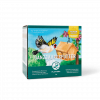
table of contents
- Garden classics
- Cut
- tool
- time
- Cut back
- After plants
- White, red berries
- Black berries
- Cutting tips
- High trunk
The sour fruits of the currant bushes are ideal for processing in the kitchen. From a culinary point of view, the vitamin-rich, round berries enhance desserts, cakes and jelly. In order to look forward to a high-yielding harvest, passionate gardeners should take a few relevant facts into account when taking care of them. Regular pruning increases the annual yield of the popular currants. The different types of trees make different demands on the hobby gardener when cutting.
Garden classics
Vitamin bomb for the garden
Currants are one of the classics among the local berry bushes. This alone shows the fact that there are different dialect names for the plant and its sour berries in Germany, Austria and Switzerland. In addition to terms such as "Ahlbeere", "Träuble", "Ribiseln" or "Meertrübeli", there is one point that distinguishes the varieties of the gooseberry family: The topic of "pruning". Black currants are cut back in a different way than red and white berry bushes.
Cut
For a productive season, the pruning of the deciduous trees is indispensable. As a rule, this measure is carried out immediately after the harvest. For early ripening berries or For strongly growing specimens, it is sometimes advisable to cut before the berries are harvested. It does not matter whether the plants are cultivated as high trunks or as a bush. Red currants can easily be raised as a spindle and multiple shoots on a wire mesh.
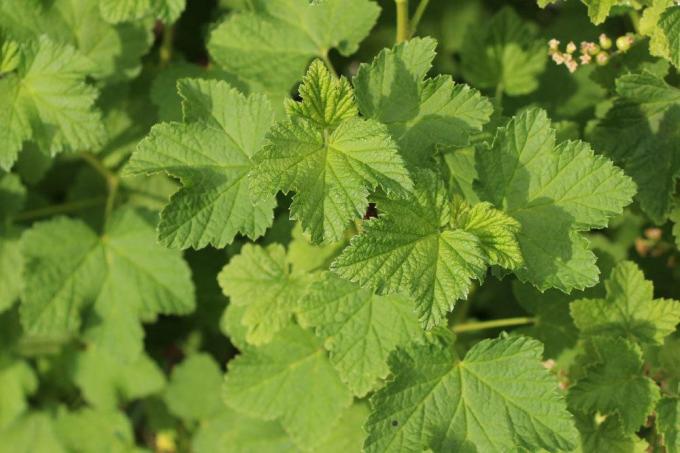
tool
The right tool
Passionate hobbyists know how important the right tools are. This also applies to work in the garden: Well-sharpened and functional tools make work easier and contribute to an effective cut. To cut berry bushes, you will need the following.
- Loppers
- Hand scissors
- Stitch resp. Folding saw
- gloves
Saws and pruning shears come inside or inside the bush. used for stronger shoots. With little effort it is possible to remove the disturbing parts of the plant quickly. The cut should be clean so that no germs or fungal pathogens can get inside the currants. This measure applies to every pruning, regardless of whether you are cutting berry bushes, deciduous or coniferous trees. For this reason, it is also advisable to disinfect the tools after work. The smaller hand scissors are suitable for fine work. Only a few millimeters thick shoots can be easily cut away.
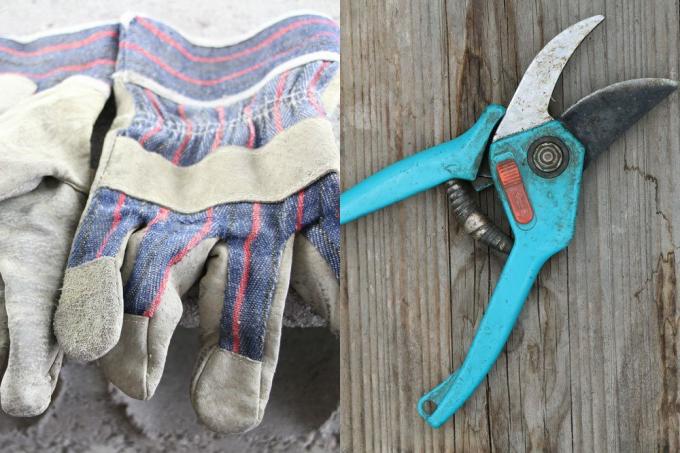
Motorized tools can be used for maintenance or facilitate the pruning of the plants. Hedge trimmers of this type are unsuitable for berry trees. Do not use these devices.
time
Whether early or late bearing varieties: If you thinning out the bushes after the harvest, this increases the health and vitality of the trees. The sunlight reaches the ripening fruits unfiltered, at the same time the harvest is made easier.
- in the spring after the frost, standard currants can be cut back
- Shorten old shoots immediately after harvest
- Remove dead and wilted plant parts all year round

Frost and excessive heat can cause enormous damage to the robust, perennial woody plants. At least when the plants have been weakened by a back and clear cut.
- Cut late-bearing varieties before the first frost
- do not shorten the shoots in the midday sun
- on the previous or cut back the currants in the late afternoon
Before the formation of new shoots and buds in spring, you should remove dead branches from the trunk or shorten near the ground. This creates space for new branches and berries. Fast-growing and fast-growing varieties, such as "Silvergieters Black", quickly recover from this measure. The gloves are by no means compulsory, but an indispensable tool for gardening. The focus is not only on protecting people, but also on plants. Just like tools, the gardener can spread germs and pathogens in the garden. For this reason, never touch the freshly cut surface of the wood with your bare hand.
Cut back
After plants
The shortening or Removal of shoots immediately after planting is only possible with the spindle or Hedge shape necessary. In single-drive training on a wire frame, several plants are grown at a minimum distance of approx. 35 cm planted. If you choose the two- to three-branch variant, you should keep a distance of at least 75 cm between the individual currant bushes. This form of cultivation is particularly suitable for hill and raised beds.
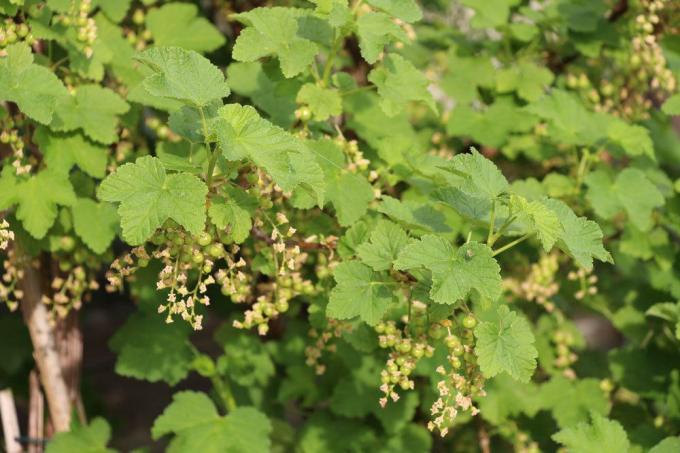
- with a single instinct only protect the leading instinct
- Shorten annoying secondary shoots immediately after planting
- with multi-shoot spindle training leave 6 to 8 annual shoots
- on the ground or Remove parts of the plant that are sprouting from the side several times a year
With other forms of education, dead or weak shoots removed. Shorten the tips of healthy plant parts by about 3 to 5 cm. This promotes bushy growth.
White, red berries
Cut back white and red varieties
In contrast to black currants, the sour-tasting fruits of red and white currants are formed on the two to three-year-old shoots. From the 4th Year the yield on these branches decreases. Annual pruning is necessary so that the older shoots can be replaced by young ground shoots. In the case of black currants, it is the annual shoots that guarantee a high-yielding harvest. Older branches can be removed here without hesitation, as long as it does not affect the statics of the entire plant.
Currants with a relatively weak growth should be cut back by about a third annually. There must be a balance between young and perennial shoots. You should heed the following tips for trees with red and white berries.
- Remove older shoots at the base of the bush
- Leave 10 to 12 main branches
- Prune close branches

Older shoots are often thick and lignified at the base. If necessary, use a saw to neatly cut away the branches. There is a trick you can use to "rejuvenate" red and white varieties: pull in a new ground shoot in good time, which will appear in the third or third time. fourth year the old main drive completely replaced. In this way you prevent the berry yield from noticeably decreasing and the entire plant "aging". You can recognize older shoots by their dark bark color. The best-known red and white Ribes varieties include, for example.
Ribes Rubrum Makosta
- Medium-late ripening wood with aromatic berries
Ribes Rubrum Rondom
- an aromatic variety that bears from the end of June
- vigorous and ideally suited for hedge training
Ribes Rubrum Jonkheer van Tets
- This early currant variety is characterized by its strong growth
Ribes Rubrum Junifer
- this plant is sensitive to frost
- blooms as early as March
Ribes Rubrum champagne
- medium-early flowering wood
- the berries have a light, champagne aroma
Ribes Rubrum Blanka
- medium early bearing variety
- high-yielding currant variety

Black berries
Cut back black currants
In trees with black berries, the yield on older shoots decreases from the 2nd Year noticeably. The disadvantage: the older branches rob the currant unnecessarily of strength and energy. If the shrub is not cut back and thinned every year, a lack of light can also lead to a poor harvest. Make room for the young shoots by removing the older ones right after harvest. Even with the black berry varieties, it is important to pay attention to the appearance or to respect the statics of the plants. At least 10 to 12 branches should be left on the wood, which hold the shrub together.
To promote a bushy appearance, you can use a trick: Leave only 3 to 4 side shoots and also cut the main shoots completely. About 4 to 6 eyes are enough for the plant to sprout powerfully. The branches that appear in the following year produce more fruit. It is by no means uncommon for weak shoots to lean to the ground under the weight of the berries. React in time and support the branch. The following are among the best-known representatives of black currants.
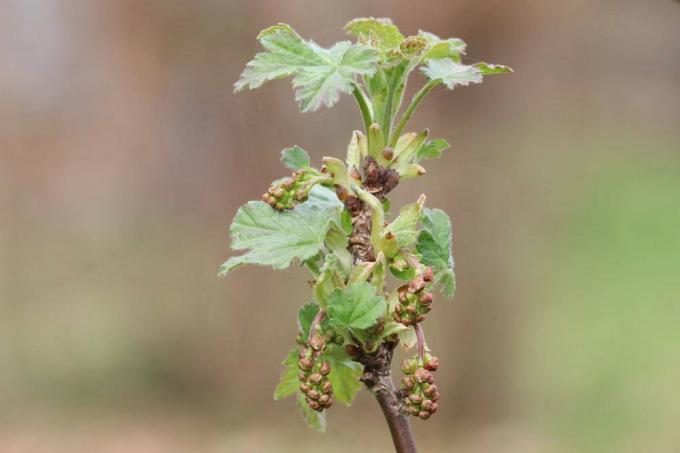
Ribes nigrum Ometa
- Variety with aromatic berries
- resistant to a wide variety of diseases and pests
Ribes nigrum Silvergieters black
- a high-yielding variety with a vigorous, upright habit
- sweet and mild berries
Ribes nigrum KieRoyal
- the self-pollinating variety has sweet fruits
- the harvest takes place from the end of June
Cutting tips
Tips for cutting the perennial woody plants
The thinning and pruning of the gooseberry plants is not difficult. Regardless of the Ribes variety, there are a few general tips that will result in a tasty and plentiful harvest. This includes, for example, the shape of the cut. Put the saw or Scissors at an angle. Rain or rain can spread on flat surfaces. Easily collect irrigation water, which in the worst case can cause rot. Unclean edges, such as those caused by insufficiently sharpened tools, should be reworked. Do not violate the main instinct. If you shorten laterally and transversely growing shoots, you should leave a small stub.

Optimal shoot lengths for different types of spindle training:
- slow or Cut back currants that are growing weakly to a length between 30 - 50 cm
- Shorten medium-weak growing varieties to 20 - 30 cm
- in the case of strongly growing specimens, you can cut the branches to a length of 5-15 cm
High trunk
Fruit varieties grown into tall trunks have long been no longer uncommon. The plants take up little space and are an eye-catcher in the garden. In addition, the woody plants can be cultivated in larger vessels without any problems. The trend does not stop at currants either. Ribes aureum, the gold currant, is used specifically for this cultivation form. Similar rules apply to tall trunks as to the bushy growing gooseberry plants.
- prune upward-growing branches
- Cut away water shoots
- remove weak shoots
- cut older, hanging branches
- Branches must not tear when pruning
- pay attention to an even crown build-up

